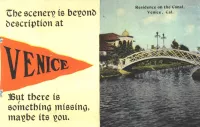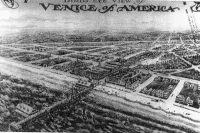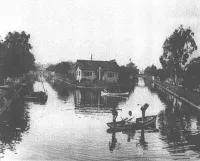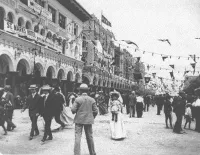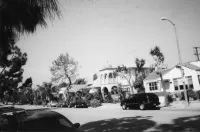Share what you know,
and discover more.
Share what you know,
and discover more.
Apr 09, 2001
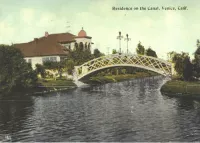
-

- Charmaine Bantugan
Henry A.Ware House - National Register of Historic Places
Statement of Significance The Venice of America House is significant under National Register of Historic Places Criteria A and C. Contextually, the house relates to the theme of community planning in Los Angeles. Completed in 1906, the house is historically significant under Criterion A as one of the first, and now oldest, residential buildings erected by the Abbot Kinney Company in Venice of America. Kinney created one of the most unusual communities in Los Angeles when he developed the beach-side resort based on the culture and architecture of Venice, Italy. The house is architectural significant under Criterion C as it embodies the distinctive characteristics of the Late Victorian style, which is made all the more exotic by the Islamic-inspired dome over the front entrance. The Late Victorian style of the house is a rarity not only in the community of Venice, but on the west side of Los Angeles in general. Criterion A Venice of America was conceived and developed at the beginning of the century by Abbot Kinney. Arriving in southern California in 1880, Kinney settled in Sierra Madre, at the foothills of the San Gabriel Mountains. At 24 years of age, Kinney had joined the family business, Kinney Brothers Tobacco Company. With an amazing gift for languages (he spoke French, Spanish, Italian, German and Arabic fluently) he was the ideal candidate for the Dob of buying foreign tobacco. After living and working abroad for several years, Kinney took a much-needed vacation and began his search for a permanent home with a climate conducive to his asthma. The crisp, pure air of Sierra Madre apparently suited him Shortly after arriving, he purchased 550 acres of land and built a house. The property was dubbed Kinnelon, meaning Kinney's Hill in Hawaiian. There he lived for many years, dabbling in citriculture, politics, and journalism. With the land boom of 1887, Kinney began buying and selling real estate all over the area. He formulated a particular plan for a Nob Hill type of community in what is now the Pacific Palisades which never came to fruition. In 1891, Kinney took a business partner, Santa Monacan Francis G. Ryan. Together they began developing a resort in the southern part of Santa Monica, later called Ocean Park. Unfortunately, Ryan died and his interest was transferred to new partners with whom Kinney had differences of opinion. The partnership was finally dissolved in 1904, and on the flip of a coin Kinney chose the undeveloped southern half of the property as his 50 percent share. Kinney immediately embarked on plans to build another resort, only this time it would be even more grandiose. Designed by landscape architects in Boston on what was thought to be worthless swampland, Venice was conceived as a beach community that would foster a cultural Renaissance. The idea of constructing the resort around a series of canals was both romantic and pragmatic, and not completely original. With Santa Monica and Ocean Park just to the north, Kinney need a concept for his community which would set it apart from the others. But more importantly, the land could not have been developed without draining the salt water. The canals were a means of controlling the water. The Venetian theme was a logical extension of the canals which also served Kinney's marketing goals. Building and canal construction began in the summer of 1904, but winter storm damage necessitated hasty rebuilding before the resort opened on July 4, 1905. Kinney's rush to build Venice of America stemmed from his desire to open before two other nearby beach resorts, Playa del Rey just to the south and Naples in south Long Beach. Transportation moguls, Moses Sherman and Eli Clark, purchased the land around Playa del Rey in 1902 with the intention of developing it as a Venetian-style resort. While the plans did not include a network of canals, it did call for bridges and towers, a bathing pavilion along the beach, and a 250-room luxury hotel. In 1904, a pavilion and small hotel were built in an Oriental Craftsman style around a lagoon. The resort was a modest success in attracting day tourists, but few investors built on their lots. Naples was developed between 1903 and 1905 by Arthur Parson's Pacific Amusement Company and Henry Huntington. They conceived a plan where they would take 340 acres of mud flats and marsh land in Los Alamitos Bay, create a large island by dredging around it, then dig three miles of canals through the island's residential district. Although the Venice plan was not totally without local precedent, it owed much to the Columbian Exposition that had been built on reclaimed lowlands along the Chicago shoreline in 1893. Kinney and his planners followed the Chicago World's Fair example in creating a detailed comprehensive town layout. Like the planned communities of later generations, Venice would separate housing areas from commercial and entertainment areas. The plan included two miles of canals laid in a fan shape, a club house, bowling alleys, a bathhouse, a dance pavilion, hotels, a casino, and a theater. Amusement activities were concentrated on a pier which extended from Windward Avenue, the location of the business district. There were 504 residential lots, of which 289 fronted on canals. Kinney hired the local architecture firm of Norman Marsh and Clarence Russell to design the principal buildings. The first sale of residential lots, located primarily in the canal district was offered to the public on Saturday, November 12, 1904. Initial lot prices, depending on the location, ranged from $600 to $1200. To prevent speculation, Kinney restricted sales to two lots per person. Kinney retained ownership of several lots on which he built houses, including the one at 1223 Cabrillo Avenue (then Cabrillo Canal). Completed in 1906, the house was rented for many years until it was purchased by John and Emma Funnell in 1918. As the original building permit for the house does not exist, the name of the architect is unknown. Marsh and Russell, the only architects associated with Kinney, may have designed the house. Even in its day, the Venice of America House stood out from its neighbors. The house appears in numerous postcard images of Venice. In one image of the canals under construction, the house appears in the distance, with the house next door as its only neighbor. Sanborn Maps and historic photographs indicate that the earliest residential buildings were predominately one-story, single-family houses, which could best be described as cottages or bungalows. A Sanborn Map from 1909 shows blocks of small wood frame houses with front porches. Kinney filled United States Island, created by surrounding canals, entirely with one-story wood bungalows. These bungalows are currently being rehabilitated. Venice was annexed by the City of Los Angeles in 1925 after a series of hotly contested elections in which amusement interests vied with permanent residents seeking increased city services and a stricter moral code. In the late 1920s the canals north of Venice Boulevard were filled in to form streets. The great Venice Lagoon became the traffic circle which today joins Main Street (once Coral Canal), Grand Boulevard (once Grand Canal), and Windward Avenue (once Lion Canal north of the Lagoon). Also, about this time, multi-family structures began to replace some of the earliest single-family houses. The development of Venice of America had a remarkable impact on the west side of Los Angeles. Surrounding land that had been thought to be worthless, was purchased and subdivided. Most lots were sold within days of being put on the market. The Venice Canal Subdivision was one such tract which owed its existence to Kinney's development. It was developed by Strong and Dickson who would dredge a two-mile-long canal to connect Kinney's canal with the Playa del Rey lagoon. These canals are listed in the National Register, but were not a part of the original Venice of America plan. The Venice of America House at 1223 Cabrillo Avenue, is historically significant as one of the oldest and last remaining buildings from Abbott Kinney's Venice of America. Criterion C The Venice of America House is an unusual example of Late Victorian architecture, with It's Islamic-inspired dome over the front entrance. Victorian architecture encompasses the revival and eclectic styles popular in England and America during the reign of Queen Victoria (1837-1901). The most widespread of these, in terms of American domestic architecture, was misnamed after Queen Anne (1702-14). It would have been more accurate if the style had been named after it principal protagonist, the English architect Richard Norman Shaw. Between approximately 1870 and 1890, Shaw had a successful practice of designing country houses. He, and his contemporaries such as Philip Webb, drew from historical precedents which had little to do with the time of Queen Anne. Instead, they borrowed most heavily from late Medieval models. Complex shapes, strongly asymmetrical facades, multi-textured or multi-colored walls, and steeply-pitched roofs were common features of the style. Virginia and Lee McAlester identify "the half-timbered Watts-Sherman house in Newport, Rhode Island as the first American example of the style" in their book, A Field Guide to American Houses. By the 1880s, however, the English models executed in stone were supplanted by the American interpretation rendered in wood and heavily decorated with spindle work. The style was spread throughout the country by pattern books and architectural magazines. The expanding railroad network also helped popularize the style by making pre-cut architectural details conveniently available through much of the nation. The second trend that was to end the Victorian era turned toward the architecture of Colonial America. This movement began with the Centennial celebrations of 1876 and picked up momentum through the 1880s and 1890s. Its influence is evident in the borrowed Georgian and Adam details seen in many late Victorian houses. Houses which merged the Queen Anne with the Colonial Revival became widespread. Typically, these hybrids would have irregular plans and asymmetrical facades found in the Queen Anne, but more subdued, classical ornamentation of the Colonial Revival. One of the earliest examples of Victorian architecture in southern California is the "Queen Anne Cottage" built on the estate of E.J. Lucky Baldwin in 1881. The largest concentration of the style occurred in the early suburbs around downtown Los Angeles, such as Angelino Heights, Westlake, and West Adams, which were constructed during the boom of the 1880s. Many examples can be found in the outer lying towns which emerged during the boom as well. When the boom abruptly turned into bust in 1887, building activity subsided. By the time the real estate market regained its composure in the 1890s, the late Victorian styles had gained popularity. By the first decade of the twentieth century, late Victorian architecture was almost completely supplanted by the Colonial Revival, and then the Craftsman. The Venice of America House is an excellent example of the Late Victorian architecture which blended the Queen Anne with the Colonial Revival. The house has the strong rectangular shape, hipped roof, and narrow clapboard siding found in the Colonial Revival While the house is void of the usual surface decoration associated with the Queen Anne style, it features decorative tripartite windows on the front and side facades. Lattice patterned transoms, common in Queen Anne houses, top the windows. The most decorative feature of the house, however, is the two-story entryway. It, like the main body of the house, is boxy in shape and may have been the designer's attempt at including the tower and front porch normally associated with Victorian architecture into the small beach lot. The turned wood railing on the balcony and the denticulated molding at the edge of the flat roof are also features typical of the Queen Anne. The double arches on the second story and the dome atop the roof, however, are references to Islamic architecture. It was not terribly uncommon during the period to use eastern architecture as sources of inspiration. The Morey House in Redlands (1887) has a Byzantine-style dome crowning a turret and the Mooers House on South Bonnie Brae Street in Los Angeles (1894) has a Moorish-inspired cupola. In west Los Angeles, there are very few houses with which to compare the Venice of America House. The other older residential buildings in Venice are predominately Craftsman. There is a good concentration of early twentieth century residential buildings on the short streets north of Windward, between the Speedway and Pacific Avenue. Virtually all, however, have suffered inappropriate alterations as a result of being converted into multifamily housing. There is also a significant cluster of bungalows from approximately the same time period on what was originally United States Island, but stylistically they blend the Craftsman with the Colonial Revival. Santa Monica and Ocean Park are the only west side communities with any Queen Anne or Late Victorian style house worthy of note, and they are few and far between. The Jones House (1894) was moved to its current site at Main Street and Ocean Park Boulevard in 1977 and functions as the California Heritage Museum. It is a simply detailed version of the Queen Anne style.
Henry A.Ware House - National Register of Historic Places
Statement of Significance The Venice of America House is significant under National Register of Historic Places Criteria A and C. Contextually, the house relates to the theme of community planning in Los Angeles. Completed in 1906, the house is historically significant under Criterion A as one of the first, and now oldest, residential buildings erected by the Abbot Kinney Company in Venice of America. Kinney created one of the most unusual communities in Los Angeles when he developed the beach-side resort based on the culture and architecture of Venice, Italy. The house is architectural significant under Criterion C as it embodies the distinctive characteristics of the Late Victorian style, which is made all the more exotic by the Islamic-inspired dome over the front entrance. The Late Victorian style of the house is a rarity not only in the community of Venice, but on the west side of Los Angeles in general. Criterion A Venice of America was conceived and developed at the beginning of the century by Abbot Kinney. Arriving in southern California in 1880, Kinney settled in Sierra Madre, at the foothills of the San Gabriel Mountains. At 24 years of age, Kinney had joined the family business, Kinney Brothers Tobacco Company. With an amazing gift for languages (he spoke French, Spanish, Italian, German and Arabic fluently) he was the ideal candidate for the Dob of buying foreign tobacco. After living and working abroad for several years, Kinney took a much-needed vacation and began his search for a permanent home with a climate conducive to his asthma. The crisp, pure air of Sierra Madre apparently suited him Shortly after arriving, he purchased 550 acres of land and built a house. The property was dubbed Kinnelon, meaning Kinney's Hill in Hawaiian. There he lived for many years, dabbling in citriculture, politics, and journalism. With the land boom of 1887, Kinney began buying and selling real estate all over the area. He formulated a particular plan for a Nob Hill type of community in what is now the Pacific Palisades which never came to fruition. In 1891, Kinney took a business partner, Santa Monacan Francis G. Ryan. Together they began developing a resort in the southern part of Santa Monica, later called Ocean Park. Unfortunately, Ryan died and his interest was transferred to new partners with whom Kinney had differences of opinion. The partnership was finally dissolved in 1904, and on the flip of a coin Kinney chose the undeveloped southern half of the property as his 50 percent share. Kinney immediately embarked on plans to build another resort, only this time it would be even more grandiose. Designed by landscape architects in Boston on what was thought to be worthless swampland, Venice was conceived as a beach community that would foster a cultural Renaissance. The idea of constructing the resort around a series of canals was both romantic and pragmatic, and not completely original. With Santa Monica and Ocean Park just to the north, Kinney need a concept for his community which would set it apart from the others. But more importantly, the land could not have been developed without draining the salt water. The canals were a means of controlling the water. The Venetian theme was a logical extension of the canals which also served Kinney's marketing goals. Building and canal construction began in the summer of 1904, but winter storm damage necessitated hasty rebuilding before the resort opened on July 4, 1905. Kinney's rush to build Venice of America stemmed from his desire to open before two other nearby beach resorts, Playa del Rey just to the south and Naples in south Long Beach. Transportation moguls, Moses Sherman and Eli Clark, purchased the land around Playa del Rey in 1902 with the intention of developing it as a Venetian-style resort. While the plans did not include a network of canals, it did call for bridges and towers, a bathing pavilion along the beach, and a 250-room luxury hotel. In 1904, a pavilion and small hotel were built in an Oriental Craftsman style around a lagoon. The resort was a modest success in attracting day tourists, but few investors built on their lots. Naples was developed between 1903 and 1905 by Arthur Parson's Pacific Amusement Company and Henry Huntington. They conceived a plan where they would take 340 acres of mud flats and marsh land in Los Alamitos Bay, create a large island by dredging around it, then dig three miles of canals through the island's residential district. Although the Venice plan was not totally without local precedent, it owed much to the Columbian Exposition that had been built on reclaimed lowlands along the Chicago shoreline in 1893. Kinney and his planners followed the Chicago World's Fair example in creating a detailed comprehensive town layout. Like the planned communities of later generations, Venice would separate housing areas from commercial and entertainment areas. The plan included two miles of canals laid in a fan shape, a club house, bowling alleys, a bathhouse, a dance pavilion, hotels, a casino, and a theater. Amusement activities were concentrated on a pier which extended from Windward Avenue, the location of the business district. There were 504 residential lots, of which 289 fronted on canals. Kinney hired the local architecture firm of Norman Marsh and Clarence Russell to design the principal buildings. The first sale of residential lots, located primarily in the canal district was offered to the public on Saturday, November 12, 1904. Initial lot prices, depending on the location, ranged from $600 to $1200. To prevent speculation, Kinney restricted sales to two lots per person. Kinney retained ownership of several lots on which he built houses, including the one at 1223 Cabrillo Avenue (then Cabrillo Canal). Completed in 1906, the house was rented for many years until it was purchased by John and Emma Funnell in 1918. As the original building permit for the house does not exist, the name of the architect is unknown. Marsh and Russell, the only architects associated with Kinney, may have designed the house. Even in its day, the Venice of America House stood out from its neighbors. The house appears in numerous postcard images of Venice. In one image of the canals under construction, the house appears in the distance, with the house next door as its only neighbor. Sanborn Maps and historic photographs indicate that the earliest residential buildings were predominately one-story, single-family houses, which could best be described as cottages or bungalows. A Sanborn Map from 1909 shows blocks of small wood frame houses with front porches. Kinney filled United States Island, created by surrounding canals, entirely with one-story wood bungalows. These bungalows are currently being rehabilitated. Venice was annexed by the City of Los Angeles in 1925 after a series of hotly contested elections in which amusement interests vied with permanent residents seeking increased city services and a stricter moral code. In the late 1920s the canals north of Venice Boulevard were filled in to form streets. The great Venice Lagoon became the traffic circle which today joins Main Street (once Coral Canal), Grand Boulevard (once Grand Canal), and Windward Avenue (once Lion Canal north of the Lagoon). Also, about this time, multi-family structures began to replace some of the earliest single-family houses. The development of Venice of America had a remarkable impact on the west side of Los Angeles. Surrounding land that had been thought to be worthless, was purchased and subdivided. Most lots were sold within days of being put on the market. The Venice Canal Subdivision was one such tract which owed its existence to Kinney's development. It was developed by Strong and Dickson who would dredge a two-mile-long canal to connect Kinney's canal with the Playa del Rey lagoon. These canals are listed in the National Register, but were not a part of the original Venice of America plan. The Venice of America House at 1223 Cabrillo Avenue, is historically significant as one of the oldest and last remaining buildings from Abbott Kinney's Venice of America. Criterion C The Venice of America House is an unusual example of Late Victorian architecture, with It's Islamic-inspired dome over the front entrance. Victorian architecture encompasses the revival and eclectic styles popular in England and America during the reign of Queen Victoria (1837-1901). The most widespread of these, in terms of American domestic architecture, was misnamed after Queen Anne (1702-14). It would have been more accurate if the style had been named after it principal protagonist, the English architect Richard Norman Shaw. Between approximately 1870 and 1890, Shaw had a successful practice of designing country houses. He, and his contemporaries such as Philip Webb, drew from historical precedents which had little to do with the time of Queen Anne. Instead, they borrowed most heavily from late Medieval models. Complex shapes, strongly asymmetrical facades, multi-textured or multi-colored walls, and steeply-pitched roofs were common features of the style. Virginia and Lee McAlester identify "the half-timbered Watts-Sherman house in Newport, Rhode Island as the first American example of the style" in their book, A Field Guide to American Houses. By the 1880s, however, the English models executed in stone were supplanted by the American interpretation rendered in wood and heavily decorated with spindle work. The style was spread throughout the country by pattern books and architectural magazines. The expanding railroad network also helped popularize the style by making pre-cut architectural details conveniently available through much of the nation. The second trend that was to end the Victorian era turned toward the architecture of Colonial America. This movement began with the Centennial celebrations of 1876 and picked up momentum through the 1880s and 1890s. Its influence is evident in the borrowed Georgian and Adam details seen in many late Victorian houses. Houses which merged the Queen Anne with the Colonial Revival became widespread. Typically, these hybrids would have irregular plans and asymmetrical facades found in the Queen Anne, but more subdued, classical ornamentation of the Colonial Revival. One of the earliest examples of Victorian architecture in southern California is the "Queen Anne Cottage" built on the estate of E.J. Lucky Baldwin in 1881. The largest concentration of the style occurred in the early suburbs around downtown Los Angeles, such as Angelino Heights, Westlake, and West Adams, which were constructed during the boom of the 1880s. Many examples can be found in the outer lying towns which emerged during the boom as well. When the boom abruptly turned into bust in 1887, building activity subsided. By the time the real estate market regained its composure in the 1890s, the late Victorian styles had gained popularity. By the first decade of the twentieth century, late Victorian architecture was almost completely supplanted by the Colonial Revival, and then the Craftsman. The Venice of America House is an excellent example of the Late Victorian architecture which blended the Queen Anne with the Colonial Revival. The house has the strong rectangular shape, hipped roof, and narrow clapboard siding found in the Colonial Revival While the house is void of the usual surface decoration associated with the Queen Anne style, it features decorative tripartite windows on the front and side facades. Lattice patterned transoms, common in Queen Anne houses, top the windows. The most decorative feature of the house, however, is the two-story entryway. It, like the main body of the house, is boxy in shape and may have been the designer's attempt at including the tower and front porch normally associated with Victorian architecture into the small beach lot. The turned wood railing on the balcony and the denticulated molding at the edge of the flat roof are also features typical of the Queen Anne. The double arches on the second story and the dome atop the roof, however, are references to Islamic architecture. It was not terribly uncommon during the period to use eastern architecture as sources of inspiration. The Morey House in Redlands (1887) has a Byzantine-style dome crowning a turret and the Mooers House on South Bonnie Brae Street in Los Angeles (1894) has a Moorish-inspired cupola. In west Los Angeles, there are very few houses with which to compare the Venice of America House. The other older residential buildings in Venice are predominately Craftsman. There is a good concentration of early twentieth century residential buildings on the short streets north of Windward, between the Speedway and Pacific Avenue. Virtually all, however, have suffered inappropriate alterations as a result of being converted into multifamily housing. There is also a significant cluster of bungalows from approximately the same time period on what was originally United States Island, but stylistically they blend the Craftsman with the Colonial Revival. Santa Monica and Ocean Park are the only west side communities with any Queen Anne or Late Victorian style house worthy of note, and they are few and far between. The Jones House (1894) was moved to its current site at Main Street and Ocean Park Boulevard in 1977 and functions as the California Heritage Museum. It is a simply detailed version of the Queen Anne style.
Apr 09, 2001
Henry A.Ware House - National Register of Historic Places
Statement of SignificanceThe Venice of America House is significant under National Register of Historic Places Criteria A and C. Contextually, the house relates to the theme of community planning in Los Angeles. Completed in 1906, the house is historically significant under Criterion A as one of the first, and now oldest, residential buildings erected by the Abbot Kinney Company in Venice of America. Kinney created one of the most unusual communities in Los Angeles when he developed the beach-side resort based on the culture and architecture of Venice, Italy. The house is architectural significant under Criterion C as it embodies the distinctive characteristics of the Late Victorian style, which is made all the more exotic by the Islamic-inspired dome over the front entrance. The Late Victorian style of the house is a rarity not only in the community of Venice, but on the west side of Los Angeles in general.
Criterion A
Venice of America was conceived and developed at the beginning of the century by Abbot Kinney. Arriving in southern California in 1880, Kinney settled in Sierra Madre, at the foothills of the San Gabriel Mountains. At 24 years of age, Kinney had joined the family business, Kinney Brothers Tobacco Company. With an amazing gift for languages (he spoke French, Spanish, Italian, German and Arabic fluently) he was the ideal candidate for the Dob of buying foreign tobacco. After living and working abroad for several years, Kinney took a much-needed vacation and began his search for a permanent home with a climate conducive to his asthma. The crisp, pure air of Sierra Madre apparently suited him Shortly after arriving, he purchased 550 acres of land and built a house. The property was dubbed Kinnelon, meaning Kinney's Hill in Hawaiian. There he lived for many years, dabbling in citriculture, politics, and journalism. With the land boom of 1887, Kinney began buying and selling real estate all over the area. He formulated a particular plan for a Nob Hill type of community in what is now the Pacific Palisades which never came to fruition. In 1891, Kinney took a business partner, Santa Monacan Francis G. Ryan. Together they began developing a resort in the southern part of Santa Monica, later called Ocean Park. Unfortunately, Ryan died and his interest was transferred to new partners with whom Kinney had differences of opinion. The partnership was finally dissolved in 1904, and on the flip of a coin Kinney chose the undeveloped southern half of the property as his 50 percent share.
Kinney immediately embarked on plans to build another resort, only this time it would be even more grandiose. Designed by landscape architects in Boston on what was thought to be worthless swampland, Venice was conceived as a beach community that would foster a cultural Renaissance. The idea of constructing the resort around a series of canals was both romantic and pragmatic, and not completely original. With Santa Monica and Ocean Park just to the north, Kinney need a concept for his community which would set it apart from the others. But more importantly, the land could not have been developed without draining the salt water. The canals were a means of controlling the water. The Venetian theme was a logical extension of the canals which also served Kinney's marketing goals. Building and canal construction began in the summer of 1904, but winter storm damage necessitated hasty rebuilding before the resort opened on July 4, 1905.
Kinney's rush to build Venice of America stemmed from his desire to open before two other nearby beach resorts, Playa del Rey just to the south and Naples in south Long Beach. Transportation moguls, Moses Sherman and Eli Clark, purchased the land around Playa del Rey in 1902 with the intention of developing it as a Venetian-style resort. While the plans did not include a network of canals, it did call for bridges and towers, a bathing pavilion along the beach, and a 250-room luxury hotel. In 1904, a pavilion and small hotel were built in an Oriental Craftsman style around a lagoon. The resort was a modest success in attracting day tourists, but few investors built on their lots. Naples was developed between 1903 and 1905 by Arthur Parson's Pacific Amusement Company and Henry Huntington. They conceived a plan where they would take 340 acres of mud flats and marsh land in Los Alamitos Bay, create a large island by dredging around it, then dig three miles of canals through the island's residential district.
Although the Venice plan was not totally without local precedent, it owed much to the Columbian Exposition that had been built on reclaimed lowlands along the Chicago shoreline in 1893. Kinney and his planners followed the Chicago World's Fair example in creating a detailed comprehensive town layout. Like the planned communities of later generations, Venice would separate housing areas from commercial and entertainment areas. The plan included two miles of canals laid in a fan shape, a club house, bowling alleys, a bathhouse, a dance pavilion, hotels, a casino, and a theater. Amusement activities were concentrated on a pier which extended from Windward Avenue, the location of the business district. There were 504 residential lots, of which 289 fronted on canals. Kinney hired the local architecture firm of Norman Marsh and Clarence Russell to design the principal buildings.
The first sale of residential lots, located primarily in the canal district was offered to the public on Saturday, November 12, 1904. Initial lot prices, depending on the location, ranged from $600 to $1200. To prevent speculation, Kinney restricted sales to two lots per person. Kinney retained ownership of several lots on which he built houses, including the one at 1223 Cabrillo Avenue (then Cabrillo Canal). Completed in 1906, the house was rented for many years until it was purchased by John and Emma Funnell in 1918. As the original building permit for the house does not exist, the name of the architect is unknown. Marsh and Russell, the only architects associated with Kinney, may have designed the house.
Even in its day, the Venice of America House stood out from its neighbors. The house appears in numerous postcard images of Venice. In one image of the canals under construction, the house appears in the distance, with the house next door as its only neighbor. Sanborn Maps and historic photographs indicate that the earliest residential buildings were predominately one-story, single-family houses, which could best be described as cottages or bungalows. A Sanborn Map from 1909 shows blocks of small wood frame houses with front porches. Kinney filled United States Island, created by surrounding canals, entirely with one-story wood bungalows. These bungalows are currently being rehabilitated.
Venice was annexed by the City of Los Angeles in 1925 after a series of hotly contested elections in which amusement interests vied with permanent residents seeking increased city services and a stricter moral code. In the late 1920s the canals north of Venice Boulevard were filled in to form streets. The great Venice Lagoon became the traffic circle which today joins Main Street (once Coral Canal), Grand Boulevard (once Grand Canal), and Windward Avenue (once Lion Canal north of the Lagoon). Also, about this time, multi-family structures began to replace some of the earliest single-family houses.
The development of Venice of America had a remarkable impact on the west side of Los Angeles. Surrounding land that had been thought to be worthless, was purchased and subdivided. Most lots were sold within days of being put on the market. The Venice Canal Subdivision was one such tract which owed its existence to Kinney's development. It was developed by Strong and Dickson who would dredge a two-mile-long canal to connect Kinney's canal with the Playa del Rey lagoon. These canals are listed in the National Register, but were not a part of the original Venice of America plan. The Venice of America House at 1223 Cabrillo Avenue, is historically significant as one of the oldest and last remaining buildings from Abbott Kinney's Venice of America.
Criterion C
The Venice of America House is an unusual example of Late Victorian architecture, with It's Islamic-inspired dome over the front entrance. Victorian architecture encompasses the revival and eclectic styles popular in England and America during the reign of Queen Victoria (1837-1901). The most widespread of these, in terms of American domestic architecture, was misnamed after Queen Anne (1702-14). It would have been more accurate if the style had been named after it principal protagonist, the English architect Richard Norman Shaw. Between approximately 1870 and 1890, Shaw had a successful practice of designing country houses. He, and his contemporaries such as Philip Webb, drew from historical precedents which had little to do with the time of Queen Anne. Instead, they borrowed most heavily from late Medieval models. Complex shapes, strongly asymmetrical facades, multi-textured or multi-colored walls, and steeply-pitched roofs were common features of the style.
Virginia and Lee McAlester identify "the half-timbered Watts-Sherman house in Newport, Rhode Island as the first American example of the style" in their book, A Field Guide to American Houses. By the 1880s, however, the English models executed in stone were supplanted by the American interpretation rendered in wood and heavily decorated with spindle work. The style was spread throughout the country by pattern books and architectural magazines. The expanding railroad network also helped popularize the style by making pre-cut architectural details conveniently available through much of the nation.
The second trend that was to end the Victorian era turned toward the architecture of Colonial America. This movement began with the Centennial celebrations of 1876 and picked up momentum through the 1880s and 1890s. Its influence is evident in the borrowed Georgian and Adam details seen in many late Victorian houses. Houses which merged the Queen Anne with the Colonial Revival became widespread. Typically, these hybrids would have irregular plans and asymmetrical facades found in the Queen Anne, but more subdued, classical ornamentation of the Colonial Revival.
One of the earliest examples of Victorian architecture in southern California is the "Queen Anne Cottage" built on the estate of E.J. Lucky Baldwin in 1881. The largest concentration of the style occurred in the early suburbs around downtown Los Angeles, such as Angelino Heights, Westlake, and West Adams, which were constructed during the boom of the 1880s. Many examples can be found in the outer lying towns which emerged during the boom as well. When the boom abruptly turned into bust in 1887, building activity subsided. By the time the real estate market regained its composure in the 1890s, the late Victorian styles had gained popularity. By the first decade of the twentieth century, late Victorian architecture was almost completely supplanted by the Colonial Revival, and then the Craftsman.
The Venice of America House is an excellent example of the Late Victorian architecture which blended the Queen Anne with the Colonial Revival. The house has the strong rectangular shape, hipped roof, and narrow clapboard siding found in the Colonial Revival While the house is void of the usual surface decoration associated with the Queen Anne style, it features decorative tripartite windows on the front and side facades. Lattice patterned transoms, common in Queen Anne houses, top the windows. The most decorative feature of the house, however, is the two-story entryway. It, like the main body of the house, is boxy in shape and may have been the designer's attempt at including the tower and front porch normally associated with Victorian architecture into the small beach lot. The turned wood railing on the balcony and the denticulated molding at the edge of the flat roof are also features typical of the Queen Anne. The double arches on the second story and the dome atop the roof, however, are references to Islamic architecture. It was not terribly uncommon during the period to use eastern architecture as sources of inspiration. The Morey House in Redlands (1887) has a Byzantine-style dome crowning a turret and the Mooers House on South Bonnie Brae Street in Los Angeles (1894) has a Moorish-inspired cupola.
In west Los Angeles, there are very few houses with which to compare the Venice of America House. The other older residential buildings in Venice are predominately Craftsman. There is a good concentration of early twentieth century residential buildings on the short streets north of Windward, between the Speedway and Pacific Avenue. Virtually all, however, have suffered inappropriate alterations as a result of being converted into multifamily housing. There is also a significant cluster of bungalows from approximately the same time period on what was originally United States Island, but stylistically they blend the Craftsman with the Colonial Revival. Santa Monica and Ocean Park are the only west side communities with any Queen Anne or Late Victorian style house worthy of note, and they are few and far between. The Jones House (1894) was moved to its current site at Main Street and Ocean Park Boulevard in 1977 and functions as the California Heritage Museum. It is a simply detailed version of the Queen Anne style.
Posted Date
Mar 23, 2022
Historical Record Date
Apr 09, 2001
Source Name
United States Department of Interior - National Park Service
Source Website
Delete Story
Are you sure you want to delete this story?





